Impact of Practice Change on Runoff Water Quality and Vegetable Yield—An On-Farm Case Study
Abstract
:1. Introduction
2. Materials and Methods
2.1. Site Description
2.2. Management Practices
2.2.1. Conventional Practice
2.2.2. Improved Practice
2.2.3. Trash Mulch Practice
2.2.4. Vegetable Only Practice
2.3. Capsicum Establishment and Fertilization
2.4. Fallow Phase
2.5. Zucchini Establishment and Fertilization
2.6. Rainfall
2.7. Sampling Description and Analysis
2.7.1. Runoff Sampling and Analysis
2.7.2. Calculation of Nutrient and Sediment Loads
2.7.3. Soil Sampling and Analysis for Nutrients
2.8. Yield Estimation
2.9. Statistical Analysis
3. Results
3.1. Rainfall and Runoff
3.2. Soil Loss, Total N, Dissolved inorganic nitrogen (DIN), Dissolved organic nitrogen (DON), Total P and Filterable reactive P (FRP) Losses
3.3. Soil Nitrate-N
3.4. Soil Phosphorus Status
3.5. Capsicum and Zucchini Yield
3.5.1. Capsicum Yield
3.5.2. Zucchini Yield
4. Discussion
4.1. Impact of Vegetable Crop Management Practices on Runoff and Water Quality
4.2. Yield and Shelf Life
4.3. Nutrient Accumulation and Leaching Losses
4.3.1. Nitrogen and Phosphorus Leaching
4.3.2. Phosphorus and Nitrogen Accumulation
5. Conclusions
Supplementary Materials
Acknowledgments
Author Contributions
Conflicts of Interest
References
- FAO. World Agriculture: Towards 2015/2030; Economic and Social Development Department of FAO: Rome, Italy, 2002. [Google Scholar]
- Drinkwater, L.E.; Snapp, S.S. Nutrients in agroecosystems: Rethinking the management paradigm. Adv. Agron. 2007, 92, 163–196. [Google Scholar]
- Hart, M.R.; Quin, B.F.; Nguyen, M.L. Phosphorus Runoff from Agricultural Land and Direct Fertilizer Effects. J. Environ. Qual. 2004, 33, 1954–1972. [Google Scholar] [CrossRef] [PubMed]
- Bunzel, K.; Schäfer, R.B.; Thrän, D.; Kattwinkel, M. Pesticide runoff from energy crops: A threat to aquatic invertebrates? Sci. Total Environ. 2015, 537, 187–196. [Google Scholar] [CrossRef] [PubMed]
- Masters, B.; Rohde, K.; Gurner, N.; Higham, W.; Drewry, J. Sediment, Nutrient and Herbicide Runoff from Canefarming Practices in the Mackay Whitsunday Region: A Field-Based Rainfall Simulation Study of Management Practices; Queensland Department of Natural Resources and Water for the Mackay Whitsunday Natural Resource Management Group: Mackay, Australia, 2008.
- Mitchell, C.; Brodie, J.; White, I. Sediments, nutrients and pesticide residues in event flow conditions in streams of the Mackay Whitsunday Region, Australia. Mar. Pollut. Bull. 2005, 51, 23–36. [Google Scholar] [CrossRef] [PubMed]
- O'Reagain, P.J.; Brodie, J.; Fraser, G.; Bushell, J.J.; Holloway, C.H.; Faithful, J.W.; Haynes, D. Nutrient loss and water quality under extensive grazing in the upper Burdekin river catchment, North Queensland. Mar. Pollut. Bull. 2005, 51, 37–50. [Google Scholar] [CrossRef] [PubMed]
- Nachimuthu, G.; Halpin, N.V.; Bell, M.J. Effect of sugarcane cropping systems on herbicide losses in surface runoff. Sci. Total Environ. 2016, 557, 773–784. [Google Scholar] [CrossRef] [PubMed]
- Masters, B.; Rohde, K.; Gurner, N.; Reid, D. Reducing the risk of herbicide runoff in sugarcane farming through controlled traffic and early-banded application. Agric. Ecosyst. Environ. 2013, 180, 29–39. [Google Scholar] [CrossRef]
- Stork, P.R.; Bennett, F.R.; Bell, M.J. The environmental fate of diuron under a conventional production regime in a sugarcane farm during the plant cane phase. Pest Manag. Sci. 2008, 64, 954–963. [Google Scholar] [CrossRef] [PubMed]
- Lovatt, J. Bundaberg region horticulture value. In Bundaberg Research Facility, Internal Statistics; Queensland Department of Agriculture and Fisheries: Bundaberg, Australia, 2012. [Google Scholar]
- Nachimuthu, G.; Kristiansen, P.; Guppy, C.; Lockwood, P.; King, K. Organic vegetable farms are not nutritionally disadvantaged compared with adjacent conventional or integrated vegetable farms in Eastern Australia. Sci. Hortic. 2012, 146, 164–168. [Google Scholar] [CrossRef]
- Chan, K.Y.; Dorahy, C.G.; Tyler, S.; Wells, A.T.; Milham, P.P.; Barchia, I. Phosphorus accumulation and other changes in soil properties as a consequence of vegetable production, Sydney region, Australia. Aust. J. Soil Res. 2007, 45, 139–146. [Google Scholar] [CrossRef]
- Wells, A.T.; Cornish, P.S.; Hollinger, E. Nutrient runoff and drainage from organic and other vegetable production systems near Sydney, Australia. In Cultivating Communities, Proceedings of the 14th IFOAM Organic World Congress, Victoria, BC, Canada, 21–28 August 2002; Thompson, R., Ed.; Canadian Organic Growers: Ottawa, ON, Canada, 2002; p. 118. [Google Scholar]
- Reef Rescue program. 2008. Available online: http://www.nrm.gov.au/national/continuing-investment/reef-programme (accessed on 15 May 2015).
- Isbell, R. The Australian Soil Classification; CSIRO: Canberra, Australia, 2002. [Google Scholar]
- Dalgliesh, N.; Cawthray, S. Determining plant available water capacity. In Soil Matters—Monitoring Soil Water and Nutrients in Dryland Farming; Dalgliesh, N., Foale, M., Eds.; CSIRO: Toowoomba, Australia, 2005. [Google Scholar]
- Wilm, H.G.; Cotton, J.S.; Storey, H.C. Experiments with critical-depth flumes for measurement of flow in debris-laden streams. EOS Trans. Am. Geophys. Union 1936, 17, 528. [Google Scholar] [CrossRef]
- Walkowiak, D.K. (Ed.) ISCO Open Channel Flow Measurement Handbook, 6th ed.; Teledyne Isco: Lincoln, NE, USA, 2008.
- Meals, D.W.; Richards, R.P.; Dressing, S.A. Pollutant Load Estimation for Water Quality Monitoring Projects; Developed for U.S. Environmental Protection Agency by Tetra Tech, Inc.: Fairfax, VA, USA, 2013; p. 21. [Google Scholar]
- United States Environmental Protection Agency. Storm Water Sampling Guidance Document; United States Environmental Protection Agency, Ed.; Office of Wastewater Enforcement and Complaince: Washington, DC, USA, 1992; p. 177.
- American Public Health Association. Standard Methods for the Examination of Water and Wastewater, 22nd ed.; American Public Health Association: Washington, DC, USA, 2012. [Google Scholar]
- Hollinger, E.; Cornish, P.S.; Baginska, B.; Mann, R.; Kuczera, G. Farm-scale stormwater losses of sediment and nutrients from a market garden near Sydney, Australia. Agric. Water Manag. 2001, 47, 227–241. [Google Scholar] [CrossRef]
- Moody, P.; Compton, B. DERM-Environment and Resource Management Chemistry Centre-Standard Analytical Procedures for Plant Samples, Soil, Soil Solution and Runoff Water Samples; Department of Environment and Resource Management: Dutton Park, Australia, 2011.
- Webster, R. Analysis of variance, inference, multiple comparisons and sampling effects in soil research. Eur. J. Soil Sci. 2007, 58, 74–82. [Google Scholar] [CrossRef]
- Nachimuthu, G.; Halpin, N.V.; Bell, M.J. Interactions between nutrient supply, tillage system and type of surface mulch on yield of vegetables grown in rotation with sugarcane—An on-farm case study. Sci. Hortic. 2017. under review. [Google Scholar]
- Kinnell, P.I.A. The influence of raindrop induced saltation on particle size distributions in sediment discharged by rain-impacted flow on planar surfaces. CATENA 2009, 78, 2–11. [Google Scholar] [CrossRef]
- Zheng, F.-L.; Huang, C.-H.; Norton, L.D. Vertical hydraulic gradient and run-on water and sediment effects on erosion processes and sediment regimes. Soil Sci. Soc. Am. J. 2000, 64, 4–11. [Google Scholar] [CrossRef]
- Lentz, R.D.; Lehrsch, G.A. Manure and Fertilizer Effects on Carbon Balance and Organic and Inorganic Carbon Losses for an Irrigated Corn Field. Soil Sci. Soc. Am. J. 2014, 78, 987–1002. [Google Scholar] [CrossRef]
- Connolly, R.D.; Ciesiolka, C.A.A.; Silburn, D.M.; Carroll, C. Distributed parameter hydrology model (Answers) applied to a range of catchment scales using rainfall simulator data. IV Evaluating pasture catchment hydrology. J. Hydrol. 1997, 201, 311–328. [Google Scholar] [CrossRef]
- Prove, B.; Doogan, V.; Truong, P. Nature and magnitude of soil erosion in sugarcane land on the wet tropical coast of north-eastern Queensland. Aust. J. Exp. Agric. 1995, 35, 641–649. [Google Scholar] [CrossRef]
- Silburn, D.M.; Glanville, S.F. Management practices for control of runoff losses from cotton furrows under storm rainfall. I. Runoff and sediment on a black Vertosol. Soil Res. 2002, 40, 1–20. [Google Scholar] [CrossRef]
- Holland, J.M. The environmental consequences of adopting conservation tillage in Europe: Reviewing the evidence. Agric. Ecosyst. Environ. 2004, 103, 1–25. [Google Scholar] [CrossRef]
- Peugeot, C.; Esteves, M.; Galle, S.; Rajot, J.L.; Vandervaere, J.P. Runoff generation processes: Results and analysis of field data collected at the East Central Supersite of the HAPEX-Sahel experiment. J. Hydrol. 1997, 188, 179–202. [Google Scholar] [CrossRef]
- Zhang, G.; Zhang, X.; Hu, X. Runoff and soil erosion as affected by plastic mulch patterns in vegetable field at Dianchi lake’s catchment, China. Agric. Water Manag. 2013, 122, 20–27. [Google Scholar] [CrossRef]
- Wan, Y.; El-Swaify, S.A. Runoff and soil erosion as affected by plastic mulch in a Hawaiian pineapple field. Soil Tillage Res. 1999, 52, 29–35. [Google Scholar] [CrossRef]
- Cox, J.W.; Oliver, D.P.; Fleming, N.K.; Anderson, J.S. Off-site transport of nutrients and sediment from three main land-uses in the Mt Lofty Ranges, South Australia. Agric. Water Manag. 2012, 106, 50–59. [Google Scholar] [CrossRef]
- Adekalu, K.O.; Okunade, D.A.; Osunbitan, J.A. Compaction and mulching effects on soil loss and runoff from two southwestern Nigeria agricultural soils. Geoderma 2006, 137, 226–230. [Google Scholar] [CrossRef]
- Prosdocimi, M.; Jordán, A.; Tarolli, P.; Keesstra, S.; Novara, A.; Cerdà, A. The immediate effectiveness of barley straw mulch in reducing soil erodibility and surface runoff generation in Mediterranean vineyards. Sci. Total Environ. 2016, 547, 323–330. [Google Scholar] [CrossRef] [PubMed]
- Rice, P.J.; Horgan, B.P. Evaluation of nitrogen and phosphorus transport with runoff from fairway turf managed with hollow tine core cultivation and verticutting. Sci. Total Environ. 2013, 456, 61–68. [Google Scholar] [CrossRef] [PubMed]
- Rice, P.J.; McConnell, L.L.; Heighton, L.P.; Sadeghi, A.M.; Isensee, A.R.; Teasdale, J.R.; Abdul-Baki, A.A.; Harman-Fetcho, J.A.; Hapeman, C.J. Runoff Loss of Pesticides and Soil. J. Environ. Qual. 2001, 30, 1808–1821. [Google Scholar] [CrossRef] [PubMed]
- Nachimuthu, G.; Halpin, N.; Bell, M. Paddock Scale Water Quality Monitoring of Vegetable-Sugarcane and Legume-Sugarcane Farming Systems—Final Technical Report Submitted to Australian and Queensland Government; Department of Agriculture, Fisheries and Forestry (QLD) & Queensland Alliance for Agriculture and Food Innovation (QAAFI), The University of Queensland: Brisbane, Australia, 2013; p. 153. [Google Scholar]
- van Grieken, M.E.; Thomas, C.R.; Roebeling, P.C.; Thorburn, P.J. Integrating economic drivers of social change into agricultural water quality improvement strategies. Agric. Ecosyst. Environ. 2012, 108, 166–175. [Google Scholar] [CrossRef]
- Ng Kee Kwong, K.F.; Bholah, A.; Volcy, L.; Pynee, K. Nitrogen and phosphorus transport by surface runoff from a silty clay loam soil under sugarcane in the humid tropical environment of Mauritius. Agric. Ecosyst. Environ. 2002, 91, 147–157. [Google Scholar] [CrossRef]
- Zhang, M.-K.; Wang, L.-P.; He, Z.-L. Spatial and temporal variation of nitrogen exported by runoff from sandy agricultural soils. J. Environ. Sci. 2007, 19, 1086–1092. [Google Scholar] [CrossRef]
- ANZECC. Australian and New Zealand Guidelines for Fresh and Marine Water Quality (2000); Australian and New Zealand Environment and Conservation Council: Canberra, Australia, 2000.
- Barlow, K.; Nash, D.; Turral, H.; Grayson, R. Phosphorus uptake and release in surface drains. Agric. Water Manag. 2003, 63, 109–123. [Google Scholar] [CrossRef]
- Stork, P.R.; Lyons, D.J.; Bell, M.J. Losses of nitrogen in surface runoff from a plantation horticulture farm in coastal Queensland, Australia. Soil Res. 2009, 47, 565–573. [Google Scholar] [CrossRef]
- Stork, P.R.; Lyons, D.J. Phosphorus loss and speciation in overland flow from a plantation horticulture catchment and in an adjoining waterway in coastal Queensland, Australia. Soil Res. 2012, 50, 515–525. [Google Scholar] [CrossRef]
- Liu, R.; Wang, J.; Shi, J.; Chen, Y.; Sun, C.; Zhang, P.; Shen, Z. Runoff characteristics and nutrient loss mechanism from plain farmland under simulated rainfall conditions. Sci. Total Environ. 2014, 468, 1069–1077. [Google Scholar] [CrossRef] [PubMed]
- Hassan, S.A.; Abidin, R.Z.; Ramlan, M.F. Growth and Yield of Chilli (Capsicum annuum L.) in Response to Mulching and Potassium Fertilization. Pertan. J. Trop. Agric. Sci. 1995, 18, 113–117. [Google Scholar]
- Jolliffe, P.A.; Gaye, M.-M. Dynamics of growth and yield component responses of bell peppers (Capsicum annuum L.) to row covers and population density. Sci. Hortic. 1995, 62, 153–164. [Google Scholar] [CrossRef]
- Cook, H.F.; Valdes, G.S.B.; Lee, H.C. Mulch effects on rainfall interception, soil physical characteristics and temperature under Zea mays L. Soil Tillage Res. 2006, 91, 227–235. [Google Scholar] [CrossRef]
- Ramakrishna, A.; Tam, H.M.; Wani, S.P.; Long, T.D. Effect of mulch on soil temperature, moisture, weed infestation and yield of groundnut in northern Vietnam. Field Crops Res. 2006, 95, 115–125. [Google Scholar] [CrossRef]
- Lee, S.K.; Kader, A.A. Preharvest and postharvest factors influencing vitamin C content of horticultural crops. Postharvest Biol. Technol. 2000, 20, 207–220. [Google Scholar] [CrossRef]
- Stefanelli, D.; Goodwin, I.; Jones, R. Minimal nitrogen and water use in horticulture: Effects on quality and content of selected nutrients. Food Res. Int. 2010, 43, 1833–1843. [Google Scholar] [CrossRef]
- Rodriguez, H.G.; Popp, J.; Gbur, E.; Chaubey, I. Environmental and economic impacts of reducing total phosphorous runoff in an agricultural watershed. Agric. Syst. 2011, 104, 623–633. [Google Scholar] [CrossRef]
- Lisson, S.N.; Cotching, W.E. Modelling the fate of water and nitrogen in the mixed vegetable farming systems of northern Tasmania, Australia. Agric. Syst. 2011, 104, 600–608. [Google Scholar] [CrossRef]
- Young, W.J.; Marston, F.M.; Davis, J.R. Nutrient Exports and Land Use in Australian Catchments. J. Environ. Manag. 1996, 47, 165–183. [Google Scholar] [CrossRef]
- Pathan, S.M.; Aylmore, L.A.G.; Colmer, T.D. Reduced leaching of nitrate, ammonium, and phosphorus in a sandy soil by fly ash amendment. Soil Res. 2002, 40, 1201–1211. [Google Scholar] [CrossRef]
- Nishimura, S.; Komada, M.; Takebe, M.; Yonemura, S.; Kato, N. Nitrous oxide evolved from soil covered with plastic mulch film in horticultural field. Biol. Fertil. Soils 2012, 48, 787–795. [Google Scholar] [CrossRef]
- Chan, K.Y.; Wells, T.; Fahey, D.; Eldridge, S.M.; Dorahy, C.G. Assessing P fertiliser use in vegetable production: Agronomic and environmental implications. Soil Res. 2010, 48, 674–681. [Google Scholar] [CrossRef]
- Hardie, M.A.; Cotching, W.E.; Doyle, R.B.; Holz, G.; Lisson, S.; Mattern, K. Effect of antecedent soil moisture on preferential flow in a texture-contrast soil. J. Hydrol. 2011, 398, 191–201. [Google Scholar] [CrossRef]
- Zhao, Y.; Luo, J.-H.; Chen, X.-Q.; Zhang, X.-J.; Zhang, W.-L. Greenhouse tomato–cucumber yield and soil N leaching as affected by reducing N rate and adding manure: A case study in the Yellow River Irrigation Region China. Nutr. Cycl. Agroecosyst. 2012, 94, 221–235. [Google Scholar] [CrossRef]
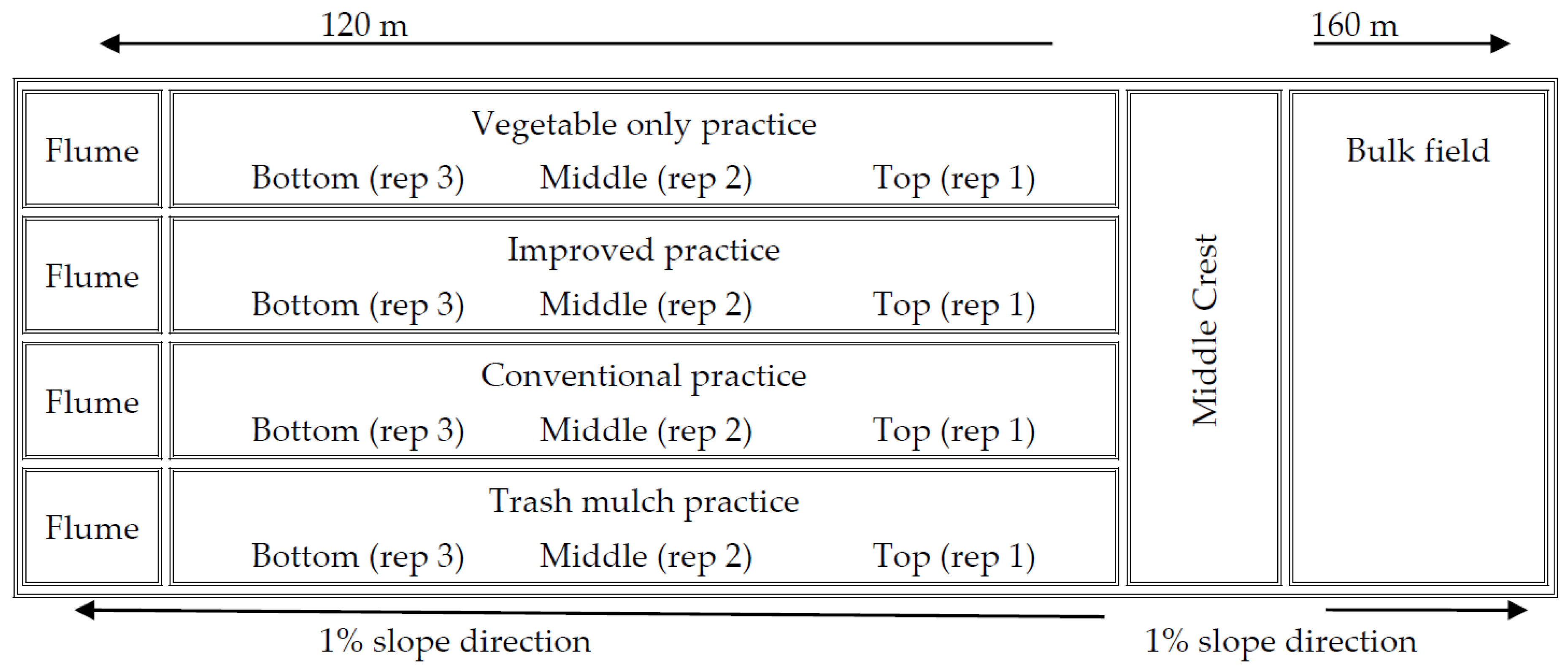
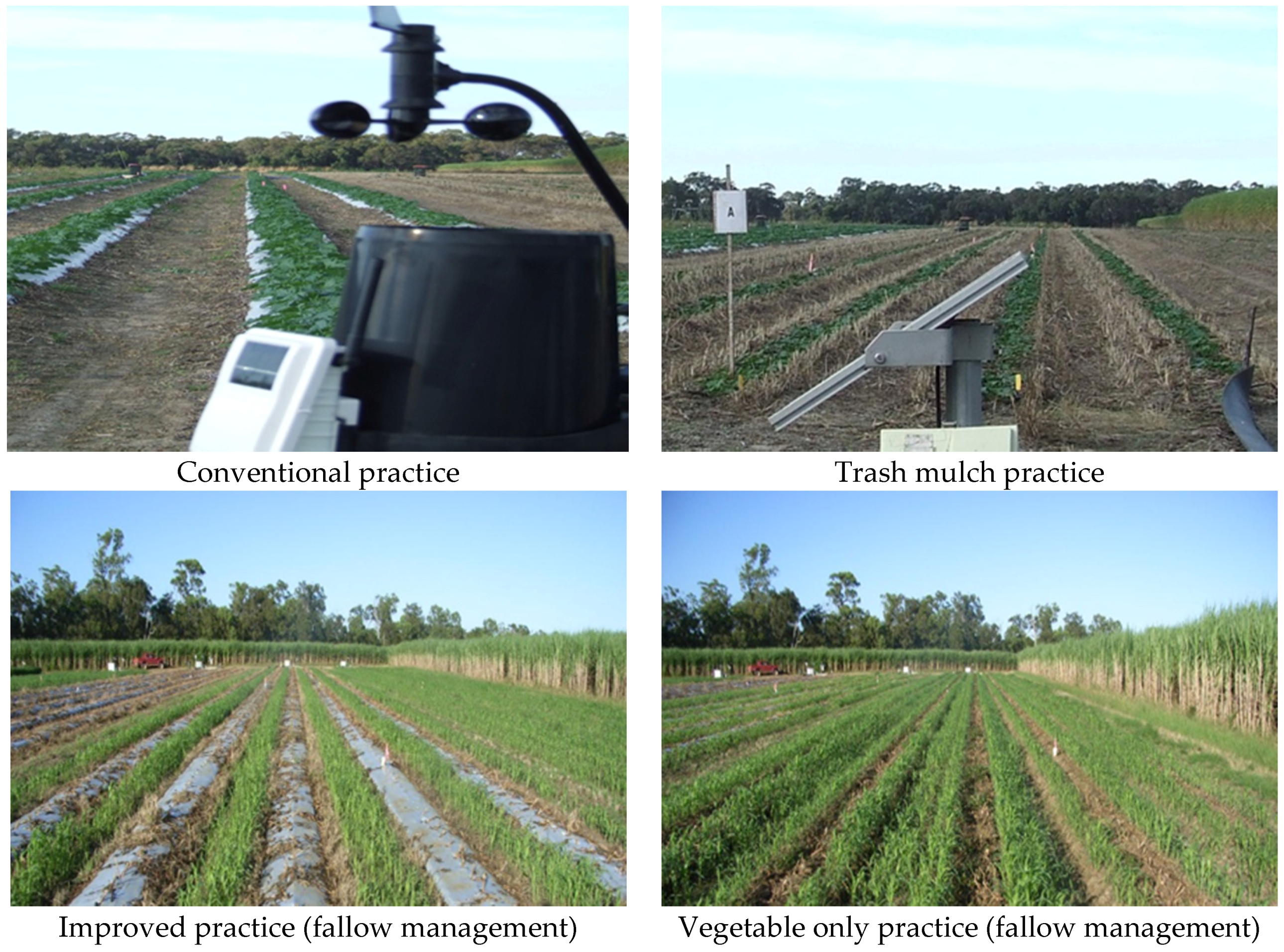
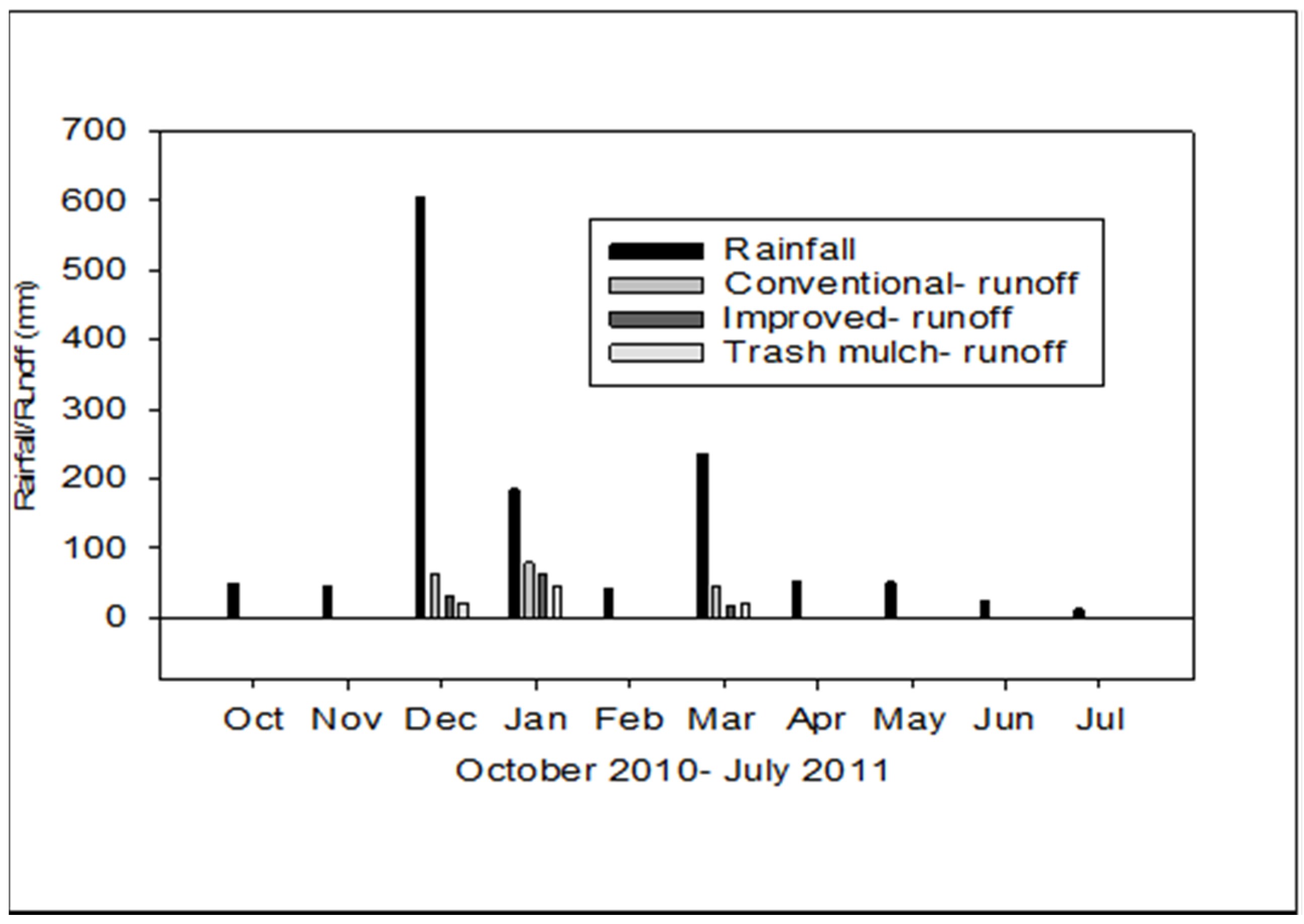
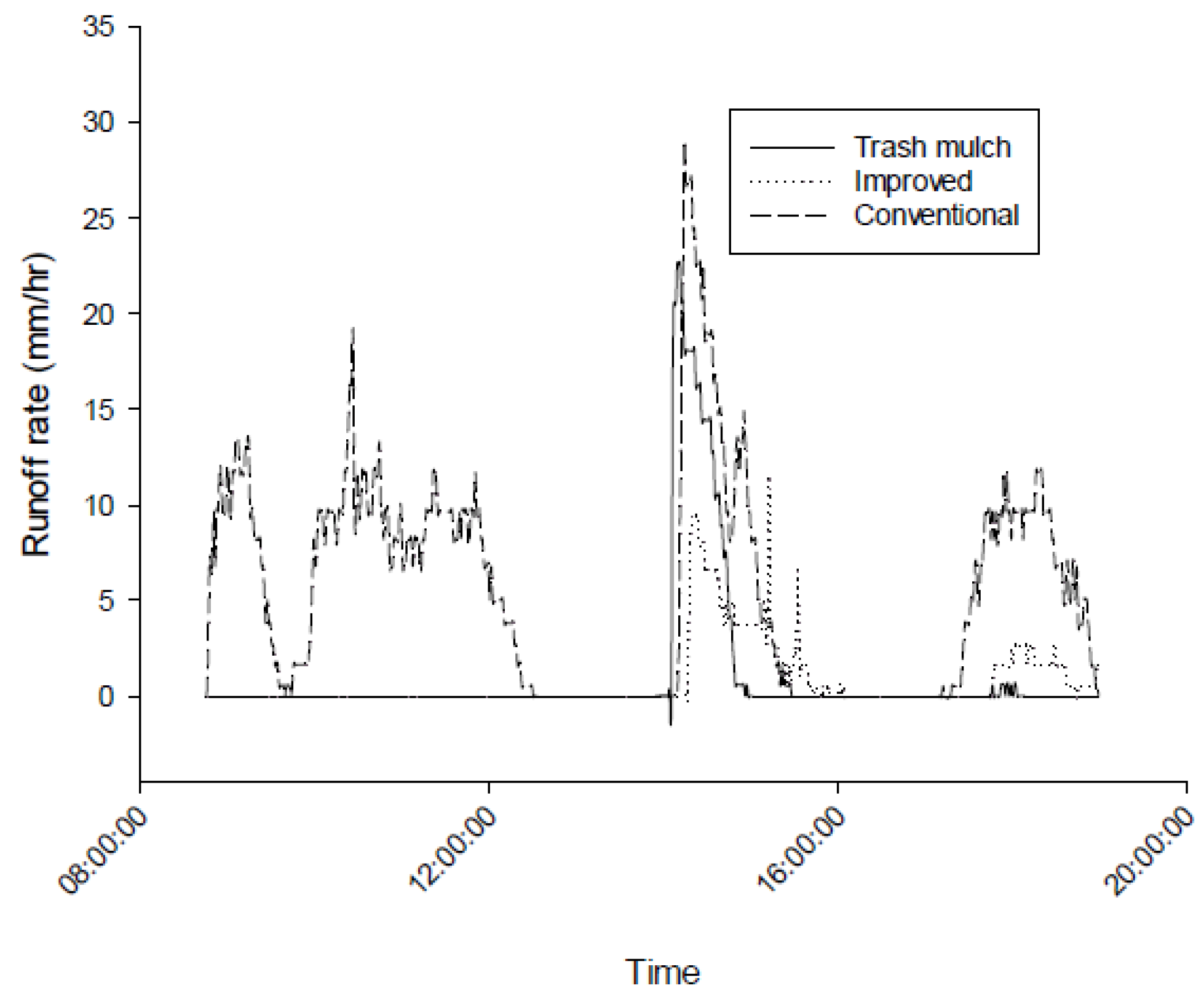
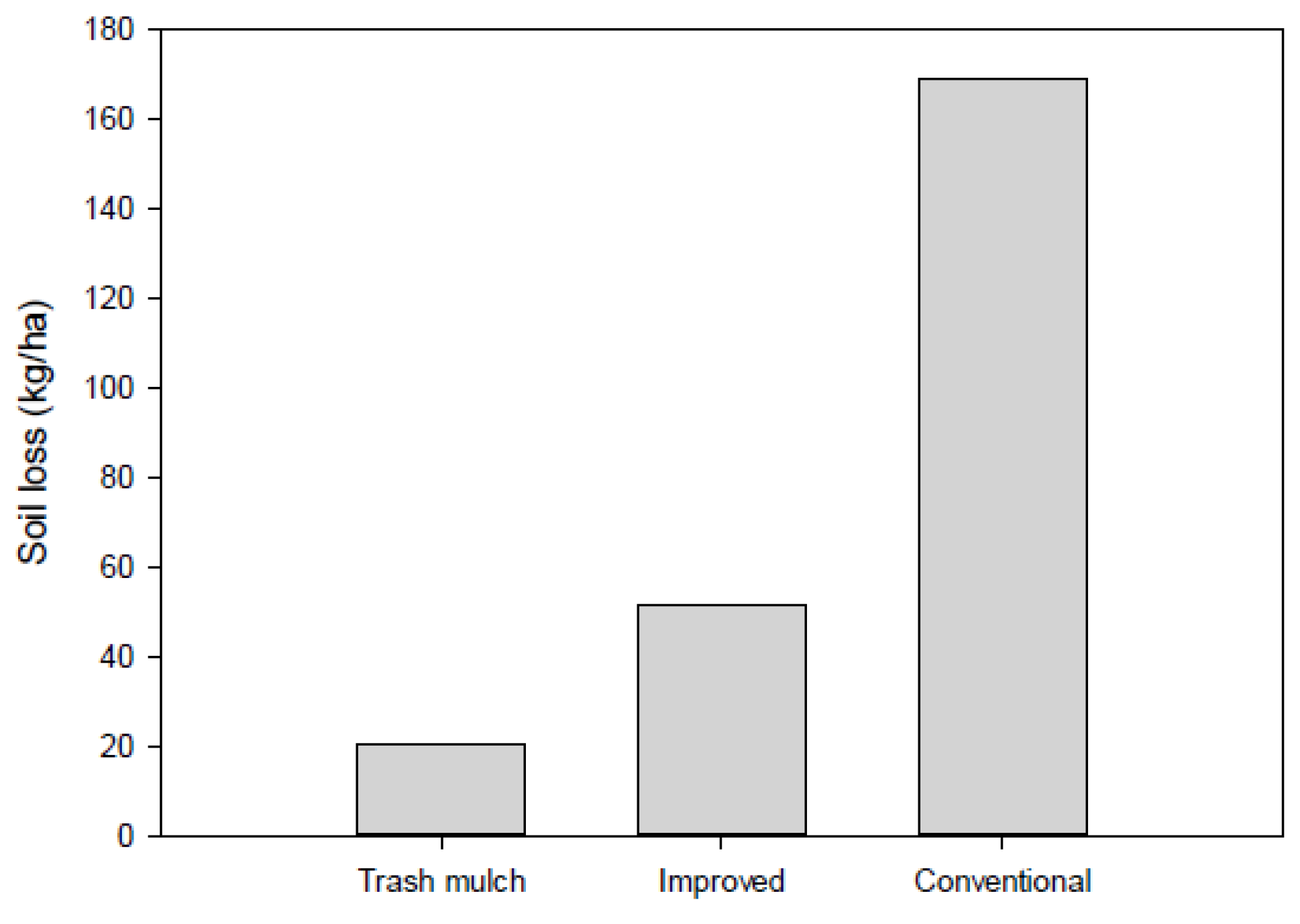



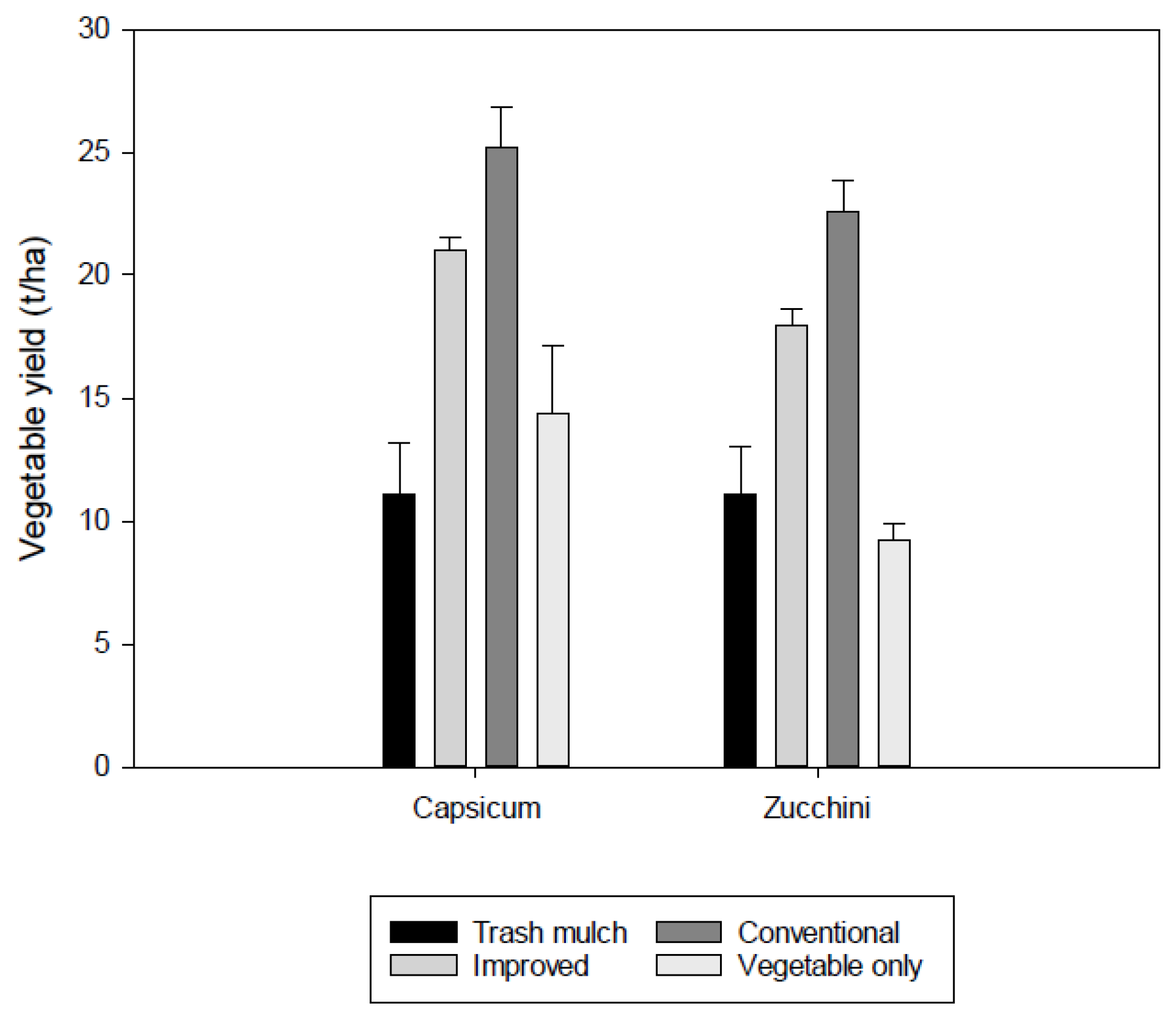

| Treatment | Conventional Practice | Improved Practice | Trash Mulch Practice | Vegetable Only Practice |
|---|---|---|---|---|
| Previous management | Cane—1.8 m PCTF # | Cane—1.8 m PCTF # | Cane—1.8 m PCTF # | Rhodes grass |
| First Crop | Capsicum | Capsicum | Capsicum | Capsicum |
| Trash Management | Removed | Removed | Retained | Retained |
| Cultivation | Full Tillage | Full Tillage | Strip | None |
| Ground cover in Bed | Plastic mulch | Plastic mulch | Trash blanket | Rhodes grass |
| Ground cover-inter-row | None | Jap millet growing | Trash blanket | Rhodes grass |
| Fertilizer | Traditional | Improved | Improved | Improved |
| N (kg/ha) | 315 | 147 | 200 | 200 |
| P (kg/ha) | 130 | 35 | 24 | 24 |
| K (kg/ha) | 306 | 175 | 200 | 200 |
| Fallow management | Knockdown herbicide | Forage sorghum grown and slashed before planting zucchini | Forage sorghum grown and slashed before planting zucchini | Forage sorghum grown and slashed before planting zucchini |
| Ground cover in Bed | Plastic mulch | Plastic mulch | Trash mulch, capsicum mulch | Rhodes grass mulch (RGM), capsicum mulch |
| Ground cover in inter-row | Capsicum mulch | Capsicum mulch, Jap millet mulch | Trash mulch, capsicum mulch | RGM, capsicum mulch |
| Second crop | Zucchini | Zucchini | Zucchini | Zucchini |
| Cultivation | No tillage | No tillage | No tillage | No tillage |
| Ground cover in Bed | Plastic mulch | Plastic mulch | Forage sorghum mulch | Forage sorghum mulch |
| Ground cover in inter-row | None | Forage sorghum mulch | Forage sorghum mulch | Forage sorghum mulch |
| Fertilizer | Soil test based | Improved | Soil test based | Soil test based |
| N (kg/ha) | 105 | 82 | 104 | 104 |
| P (kg/ha) | 8 | 13 | 19 | 19 |
| K (kg/ha) | 111 | 76 | 86 | 86 |
| Sample | Analyte | Name | PQL * | Unit | Method Description |
|---|---|---|---|---|---|
| Water | NH4-N | Ammonium nitrogen as N | 0.002 | mg/L | Water: Nutrients (NH4 NOX PO4) dissolved segmented flow analysis |
| Water | NOX-N | Oxidised nitrogen as N | 0.001 | mg/L | Water: Nutrients (NH4 NOX PO4) dissolved segmented flow analysis |
| Water | PO4-P | Phosphate phosphorus as P | 0.001 | mg/L | Water: Nutrients (NH4 NOX PO4) dissolved segmented flow analysis |
| Water | DKN | Dissolved Kjeldahl nitrogen as N | 0.04 | mg/L | Water: Nutrients (DKN DKP) dissolved AA |
| Water | DKP | Dissolved Kjeldahl phosphorus as P | 0.02 | mg/L | Water: Nutrients (DKN DKP) dissolved AA |
| Water | TKN | Total Kjeldahl nitrogen as N | 0.04 | mg/L | Water: Nutrients (TKN TKP) low level AA |
| Water | TKP | Total Kjeldahl phosphorus as P | 0.02 | mg/L | Water: Nutrients (TKN TKP) low level AA |
| Water | EC | Conductivity at 25 °C | 5 | µS/cm | Water: pH + EC + Alkalinity |
| Water | pH | pH at 25 °C | 0 | Water: pH + EC + Alkalinity | |
| Water | TSS | Total suspended solids | 1 | mg/L | Water: Solids total suspended gravimetric |
| Soil | NH4-N | Ammonium Nitrogen | 1 | mg/kg | Soil: NO3-N NH4-N extractable 1 M KCl; AA |
| Soil | NO3-N | Nitrate nitrogen | 1 | mg/kg | Soil: NO3-N NH4-N extractable 1 M KCl; AA |
| Soil | KCl-P | Phosphorus | 50 | µg/kg | Soil: P extractable 1 M KCl; AA |
| Soil | Colwell-P | Phosphorus | 2 | mg/kg | Soil: P extractable 0.5 M NaHCO3; AA |
© 2017 by the authors. Licensee MDPI, Basel, Switzerland. This article is an open access article distributed under the terms and conditions of the Creative Commons Attribution (CC BY) license ( http://creativecommons.org/licenses/by/4.0/).
Share and Cite
Nachimuthu, G.; Halpin, N.V.; Bell, M.J. Impact of Practice Change on Runoff Water Quality and Vegetable Yield—An On-Farm Case Study. Agriculture 2017, 7, 30. https://doi.org/10.3390/agriculture7030030
Nachimuthu G, Halpin NV, Bell MJ. Impact of Practice Change on Runoff Water Quality and Vegetable Yield—An On-Farm Case Study. Agriculture. 2017; 7(3):30. https://doi.org/10.3390/agriculture7030030
Chicago/Turabian StyleNachimuthu, Gunasekhar, Neil V. Halpin, and Michael J. Bell. 2017. "Impact of Practice Change on Runoff Water Quality and Vegetable Yield—An On-Farm Case Study" Agriculture 7, no. 3: 30. https://doi.org/10.3390/agriculture7030030






